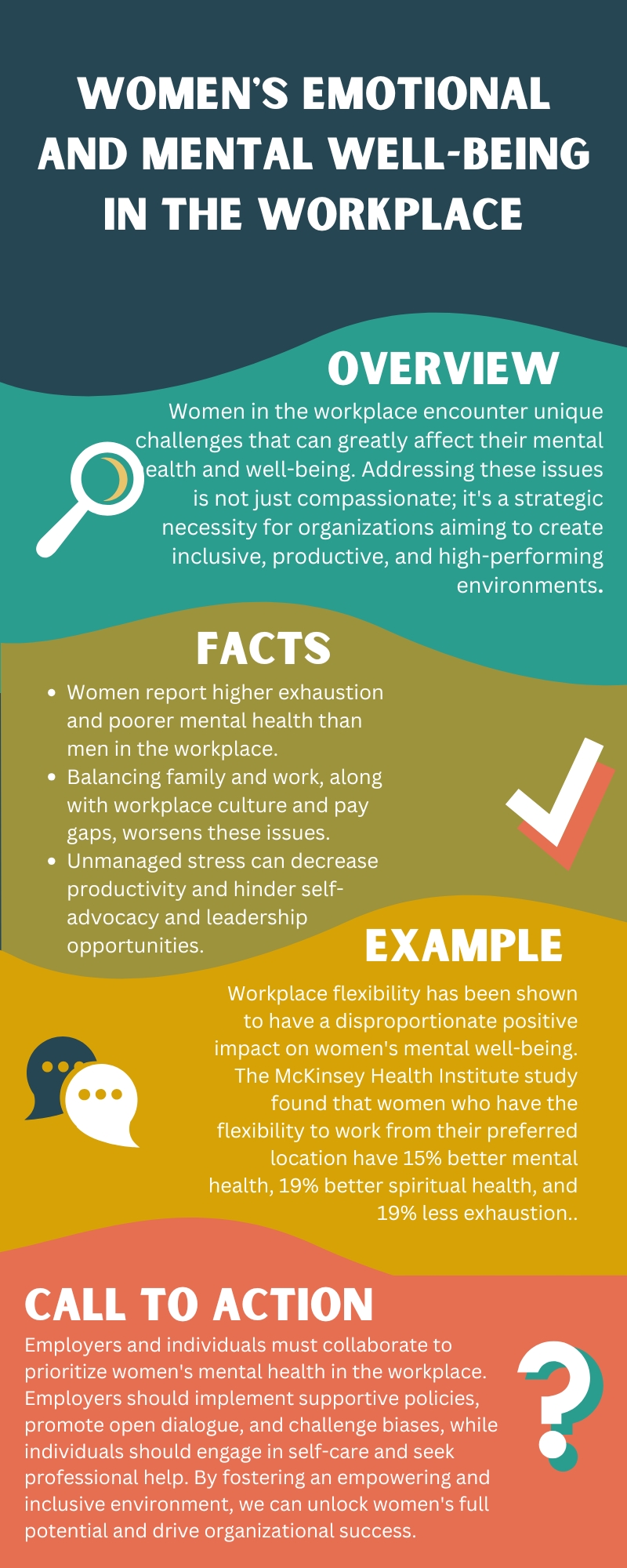In today’s fast-paced and demanding work environment, prioritizing women’s mental health has become a strategic imperative and a competitive advantage for organizations.
This shift reflects a growing understanding of the profound impact mental well-being has on individual performance, team dynamics, and organizational success.
This blog article will discuss the factors that influence women’s mental health in the workplace and outline proven strategies to foster supportive and empowering environments where women can thrive.
Strategies for Employers and Individuals to Support Women’s Mental Well-being!
Employer Strategies Individual Strategies 1. Increase support for caregivers 1. Prioritize physical health 2. Reduce microaggressions 2. Seek professional help 3. Increase workplace flexibility 3. Practice meditation 4. Foster open communication and dialogue 4. Engage in journaling for self-reflection 5. Avoid judgment 5. Establish a routine 6. Provide targeted support for women’s health needs 6. Curate a positive newsfeed 7. Promote mental wellness initiatives 8. Invest in mental health training for managers

The Current State of Women’s Mental Health in the Workplace
1. Statistics on Women and Mental Health
Recent research paints a concerning picture of women’s mental health in the workplace. A 2023 study by the McKinsey Health Institute surveyed over 30,000 employees across 30 countries and found that women are more exhausted and experience poorer mental and spiritual health than men, putting them at higher risk of burnout.
The data shows that women report lower holistic health across the board compared to their male counterparts.
2. Understanding the Reasons Behind the Statistics
| Aspect | Description |
|---|---|
| Societal Expectations | Historically, women’s roles were confined to family and household duties. Societal changes, including urbanization, technological progress, and increased access to education, have led to more women joining the workforce. This creates a dual burden of family and professional responsibilities, resulting in heightened stress and pressure. |
| Workplace Culture | Modern workplaces face increasing stress levels due to non-standard work arrangements. Female workers often experience higher exhaustion, lower job security, and reduced salaries compared to men, contributing to mental health challenges. |
| Interplay of Biological and Social Factors | Hormonal changes, reproductive health issues, and caregiving responsibilities uniquely challenge women’s mental health in the workplace, exacerbated by societal expectations and workplace dynamics. |
The Impact of Mental Health on Women’s Careers
Unmanaged stress in the workplace can lead to a range of problems, affecting both personal and organizational health.
Prolonged stress can result in decreased productivity, strained relationships with colleagues and family members, and even broader societal consequences if women are unable to reach their full career potential due to mental health challenges.
One of the key challenges women face is the ability to advocate for themselves in the workplace, particularly when it comes to negotiating salaries and seeking leadership roles.
The combination of societal expectations, workplace biases, and personal experiences can make it difficult for women to effectively advocate for their needs and career aspirations, further impacting their mental well-being and long-term career trajectories.

Strategies for Employers to Support Women’s Mental Well-being
1. Creating a Supportive and Inclusive Workplace
a. Increase Support for Caregivers
While there has been progress in men increasingly sharing caregiving responsibilities with women, the persistent unequal divide in unpaid labor, such as caregiving, continues to disproportionately impact women. Employers can provide specialized coaching and support programs to help caregivers manage their responsibilities, reducing exhaustion and improving talent retention.
b. Reduce Microaggressions
Microaggressions, subtle yet damaging comments or actions that communicate negative or derogatory messages about a person’s identity or experiences, can have a significant impact on workplace mental health. Employers should implement training and policies to address and mitigate microaggressions, fostering a more inclusive and respectful work environment.

c. Increase Flexibility at Work
The COVID-19 pandemic has demonstrated the value of workplace flexibility, with a vast majority of employees citing remote work and schedule control as top company benefits, second only to healthcare. This flexibility has a disproportionate impact on women, as the McKinsey Health Institute study found that women who have the flexibility to work from their preferred location have 15% better mental health, 19% better spiritual health, and 19% less exhaustion.
d. Open Communication and Dialogue
Organizations and managers need to understand that people are their greatest resource, and if employees cannot bring their authentic selves to the workplace, the organization is not tapping into that resource effectively. It is crucial to break the taboo around women-specific topics, such as menstruation, menopause, and their connection to mental health, and create an open and supportive environment for these discussions.
e. Avoid Judgment
Employers should strive to create a culture where women feel comfortable discussing their mental health needs without fear of judgment or repercussions. This includes fostering an environment where women can advocate for themselves, negotiate salaries, and seek leadership roles without facing biases or discrimination.

2. Targeted Support for Women
Investing in women’s health and well-being is not just a moral obligation for employers—it’s a strategic imperative that enhances overall workplace effectiveness. Here are some key initiatives organizations can adopt to support women more effectively:
a. Empowerment Through Involvement
Employers should actively involve women in decision-making processes. By listening to their perspectives and needs, organizations can create a more inclusive environment that fosters trust and collaboration.
b. Tailored Health and Wellness Benefits
Providing health and wellness benefits that specifically address women’s needs can significantly impact their well-being. This could include:
- Period Leave: Innovative measures like period leave allow women to rest during the initial days of menstruation, recognizing the physical challenges they may face.
- Extended Maternity and Childcare Leave: Offering generous maternity and childcare leave policies not only supports women during critical life stages but also signals strong employer support for their journeys.
c. Creating Safe Working Environments
It’s essential to cultivate a workplace where women feel safe to discuss their health requirements openly. This includes fostering a culture of openness and support that encourages women to voice their needs without fear of judgment.
d. Addressing Menopause
Understanding and addressing the impact of menopause on women’s mental health is crucial. The Equality and Human Rights Commission (EHRC) in the UK has recently issued guidance highlighting that employers could face legal action for disability discrimination if they fail to make “reasonable adjustments” for women experiencing menopausal symptoms. By proactively addressing these issues, organizations can create a more supportive and equitable workplace.

3. Promote Mental Wellness Initiatives
Employers should invest in comprehensive mental wellness initiatives that cater to the unique needs of women in the workplace. These can include:
- Offering access to mental health professionals, such as therapists or counselors, either on-site or through digital platforms.
- Providing mental health education and awareness workshops to destigmatize the topic and empower employees to prioritize their well-being.
- Implementing stress management programs, such as yoga, meditation, or mindfulness classes, to help employees develop healthy coping mechanisms.
- Encouraging a work culture that values and supports work-life balance, allowing employees to take necessary breaks and recharge.
4. Invest in Mental Health Training for Managers
To effectively support women’s mental well-being, employers should invest in training programs that equip managers with the skills and knowledge to recognize and address mental health concerns. This training should cover topics such as:
- Identifying the signs of mental health issues, including burnout and depression
- Fostering open and empathetic conversations about mental health
- Providing resources and guidance on how to support employees experiencing mental health challenges
- Promoting a culture of understanding and destigmatizing mental health in the workplace
By empowering managers to be champions of mental health, organizations can create a more supportive and inclusive environment where women feel heard, understood, and empowered to prioritize their well-being.

Individual Strategies for Managing Stress and Improving Mental Well-Being
While employers play a crucial role in supporting women’s mental health, individuals can also take proactive steps to manage stress and improve their overall well-being. Here are some effective strategies:
1. Prioritize Physical Health
Engaging in regular physical activity can act as a powerful stress reliever. Exercise releases feel-good endorphins and other natural neural chemicals that can improve mood and overall well-being. Complementing physical activity with a balanced diet rich in fruits, vegetables, and whole grains can also contribute to better mental health.
2. Seek Professional Help
For women experiencing more severe or persistent mental health challenges, seeking professional help can be immensely beneficial. Services like online therapy (e-therapy) have become increasingly accessible, making it easier for individuals to connect with licensed mental health professionals from the comfort of their own homes.
3. Practice Meditation
Meditation is a time-honored practice that focuses on relaxing the mind and fostering a sense of inner calm. Incorporating regular meditation into one’s routine can help reduce stress, improve focus, and enhance overall emotional well-being.

4. Journaling for Self-Reflection
Expressing thoughts and feelings through journaling can be a powerful tool for self-reflection and stress management. Guided journals or mental health workbooks can provide a structured approach to help individuals process their experiences and find clarity.
5. Establish a Routine
Maintaining a consistent schedule or planning one’s day can help prevent stressors and provide a sense of structure and control. Writing in a physical planner can help individuals remember all of their responsibilities while also offering a break from digital screens.
6. Curate a Positive Newsfeed
Constantly consuming negative news can be detrimental to one’s mental health. Individuals should be mindful of the content they expose themselves to and actively curate a newsfeed that promotes positivity and well-being.
Conclusion
Women’s mental and emotional well-being in the workplace is a pressing issue that requires attention from both employers and individuals. Organizations can empower women to thrive by creating inclusive environments with support, flexibility, and resources.
Adopting individual strategies for stress management and seeking help is equally crucial. Addressing women’s health needs is not just compassionate but a strategic imperative for fostering productive and high-performing workplaces.
By implementing supportive policies, promoting open dialogue, and challenging biases, companies can cultivate a culture where women feel valued and empowered to reach their full potential.
Together, employers and individuals can create workplaces that prioritize women’s mental well-being, paving the way for a more equitable and thriving future.
FAQs
Q1. Why do women experience poorer mental health in the workplace compared to men?
- Women juggle family and work responsibilities, increasing stress levels.
- Factors like workplace culture, job insecurity, and pay gaps contribute to mental health issues.
- Biological and social factors, including hormonal changes and caregiving roles, impact well-being.
Q2. How does poor mental health affect women’s career advancement?
- Unmanaged stress can lead to decreased productivity and strained relationships.
- Women may struggle with salary negotiations and leadership roles due to biases and societal expectations.
- Mental health challenges can hinder women’s career potential and broader societal progress.
Q3. What can employers do to support women’s mental well-being in the workplace?
- Offer caregiver support, reduce microaggressions, and provide flexible work options.
- Encourage open communication, provide targeted health support, and promote mental wellness initiatives.
- Train managers to recognize and address mental health concerns effectively.
Q4. What individual strategies can women use to manage stress and improve mental well-being?
- Prioritize physical health through exercise and a balanced diet.
- Seek professional help for serious mental health issues.
- Practice mindfulness through meditation and journaling.
- Establish a routine and curate a positive newsfeed for overall well-being.



